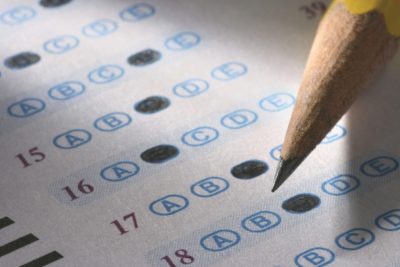
Editor’s Note: This story, authored by Loretta Waldman, originally appeared on UConn Today, the University of Connecticut’s news website.
Closing the college attainment gap among minority and low-income students has been a longstanding challenge for education policy makers. Recently published research out of UConn suggests that a simple, low-cost intervention may offer an effective solution.
The study by Joshua Hyman, an assistant professor of public policy and educational leadership at UConn, looks at a policy in Michigan requiring 11th grade students to take the ACT and compares the change in the rate of students going to college before and after implementation of the policy. The findings, published in the summer 2017 issue of the journal Education Finance and Policy, show a one percentage point bump in four-year college enrollment among poor students.
The increase may not seem all that dramatic, but relative to other educational interventions, this policy is inexpensive and easy to implement on a large scale, Hyman writes. At the time of the study, 11 states had incorporated the ACT or SAT into their 11th grade statewide assessment. All 11 states require students to take the exams and and pay for them at a cost of $32 to $50 per student.
“Sometimes minor, cheap policies can have a small impact, and if you stack enough of them up, they can make a big difference.”
— Joshua Hyman, Assistant Professor

“This is a policy that is not super flashy, but sometimes minor, cheap policies can have a small impact, and if you stack enough of them up, they can make a big difference,” he says.
Hyman analyzed data on 11th-graders taking the college entrance exam from 2003 to 2008. He looks at demographic data such as sex, race, and date of birth, as well as socioeconomic factors such as free and reduced-price lunch status, limited English proficiency, special education status, and the student’s home address. The data also included eighth and 11th grade state assessment results and college enrollment information.
By comparing the data before and after 2007, when Michigan implemented the policy, he says he was able to figure out how many students, particularly low-income students, aren’t taking the ACT or SAT, and to predict who would score well and be eligible to go to a four-year college if they did take it. His findings show that for every 10 poor students who took a college entrance exam before they were mandatory, there were an additional five students who didn’t take the test but who would score well enough to get into college if they did.
“This policy in a sense increased the supply of poor students who are taking these college entrance exams and scoring well by 50 percent,” he says. “I found that to be a pretty surprising result – that there are a lot of disadvantaged students out there who would do well on these tests but just aren’t taking them. “
Hyman further examined the effects of mandating and paying for the ACT by comparing before and after trends among students attending high schools used as test centers to those attending non-test center schools. Just the fact that some students have to drive to another school to take the test may lead to some of them not taking it. Non-test center schools tend to have lower test-taking rates and would show a bigger jump in college enrollment, he reasoned. Indeed, the study findings bore his theory out, showing a 0.6 point increase in college enrollment. The effect was even larger among boys, 0.9 points; poor students, 1.0 point; and students in the poorest high schools, 1.3 points.
The study also found that the students compelled to take the ACT tend to stay in college. Hyman was able to follow all six groups of students through their second year of college and found that the majority of them did not drop out, a key concern with policies such as a mandatory ACT.
“I think the paper has some really uncontroversial, easy, helpful policy implications,” he says. “At $34 a student or so, this policy is quite cheap. It is really hard to move the needle statewide on the rate of students going to college or the rate of low income students going to college. If this policy moves the needle by just a little bit, that’s helpful and that’s important.”
Still, the mandatory ACT is far from a cure-all, he notes. The results suggest that requiring all students to take a college entrance exam increases the supply of poor students scoring at a college-ready level by nearly 50 percent. Yet the policy increases the number of poor students enrolling at a four-year institution by only six percent.
“In spite of the policy, there remains a large supply of disadvantaged students who are high-achieving and not on a path to enrolling at a four-year college,” he writes. “Researchers and policy makers are still faced with the important question of which policies can further stem the tide of rising inequality in educational attainment.”
Access the story as it originally appeared on UConn Today.


